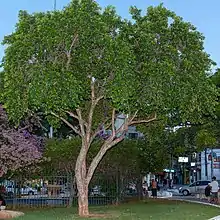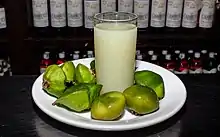Campomanesia phaea
Campomanesia phaea is a species of plant in the family Myrtaceae. The plant is endemic to the Atlantic Forest ecoregion in southeastern Brazil. It is found in the states of Paraná, Rio de Janeiro, São Paulo.[3]
| Campomanesia phaea | |
|---|---|
 | |
| Campomanesia phaea | |
| Scientific classification | |
| Kingdom: | Plantae |
| Clade: | Tracheophytes |
| Clade: | Angiosperms |
| Clade: | Eudicots |
| Clade: | Rosids |
| Order: | Myrtales |
| Family: | Myrtaceae |
| Genus: | Campomanesia |
| Species: | C. phaea |
| Binomial name | |
| Campomanesia phaea (Berg) Landrum | |
| Synonyms[2] | |
| |
In Brazil its fruit is called cambuci and the tree cambucizeiro. Not to be confused with cambucá.
Description
-_na_esquerda-direita_%C3%A9_o_fruto_maduro_e_no_centro_%C3%A9_o_fruto_verde.jpg.webp)
Campomanesia phaea is a semi-deciduous tree with peeling bark, that grows to between 4 and 9 metres tall. It produces dark green, saucer shaped fruits around 70mm in diameter.[4]
This species has a low propagation rate, and efforts have been made to propagate it in vitro.[5]
Etymology
The name 'cambuci' comes from the Tupi-Guarani word for clay pot, because of the resemblance between the fruit and Tupi-Guarani earthenware.[6]
Uses

Campomanesia phaea is often cultivated in domestic gardens and orchards, for ornamental and culinary purposes. It is rare in the wild.[4]
The cambuci fruit has a acidic, astringent flavour. It can either be eaten either raw or prepared into jellies, sherbets, or juices.[7] The fruit is rich in vitamins and minerals and is also a source of phenolic compounds.[8]
References
- World Conservation Monitoring Centre (1998). "Campomanesia phaea". IUCN Red List of Threatened Species. 1998: e.T35332A9927420. doi:10.2305/IUCN.UK.1998.RLTS.T35332A9927420.en. Retrieved 16 December 2017.
- "Campomanesia phaea (O.Berg) Landrum". The Plant List. Retrieved January 26, 2021.
- "Campomanesia phaea (O.Berg) Landrum". Plants of the World Online. Kew Science. Retrieved January 26, 2021.
- "Campomanesia phaea (O.Berg) Landrum". Useful Tropical Plants. Retrieved January 26, 2021.
- Aparecido Demétrio, Christian; Fernanda de Oliveira Jacob, Jessica; Bovi Ambrosano, Guilherme; Tiago de Oliveira, Ênio; Hercílio Viegas Rodrigues, Paulo (January 7, 2021). "In vitro propagation of cambuci (Campomanesia phaea): An endangered exotic fruit and ornamental plant from Brazilian Atlantic Forest". Plant Cell, Tissue and Organ Culture (PCTOC).
- María Lúcia Kawasaki; Leslie Landrum; Leslie Landrum (1997). "A rare and potentially economic fruit of Brazil: Cambuci, Campomanesia phaea (Myrtaceae)". Economic Botany. 51 (4): 403–405. doi:10.1007/BF02861053.
- "Campomanesia phaea". Biodiversity for Food and Nutrition. Retrieved January 26, 2021.
- Tatiane de O.Tokairin; Horst Bremer Neto; Angelo P.Jacomino (2018). Exotic Fruits Reference Guide. pp. 91–95. doi:10.1016/B978-0-12-803138-4.00013-7.
| Wikimedia Commons has media related to Campomanesia phaea. |
